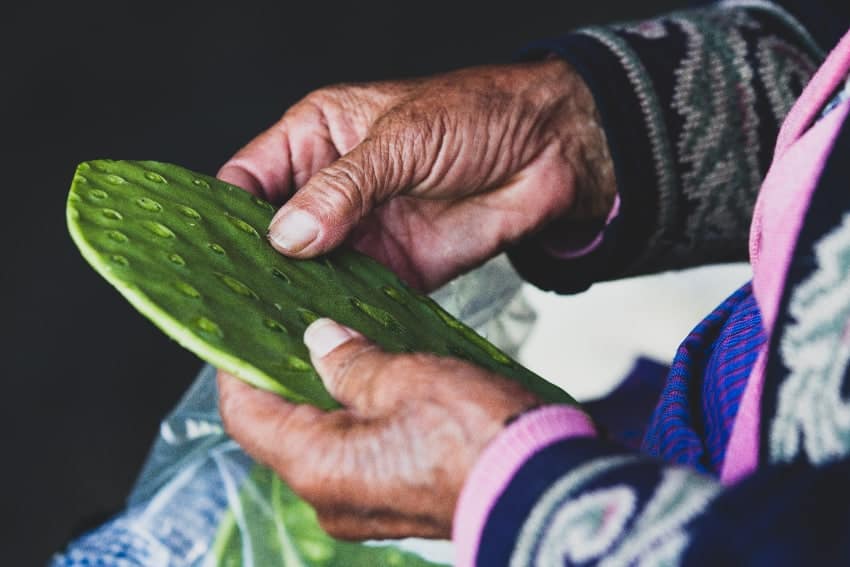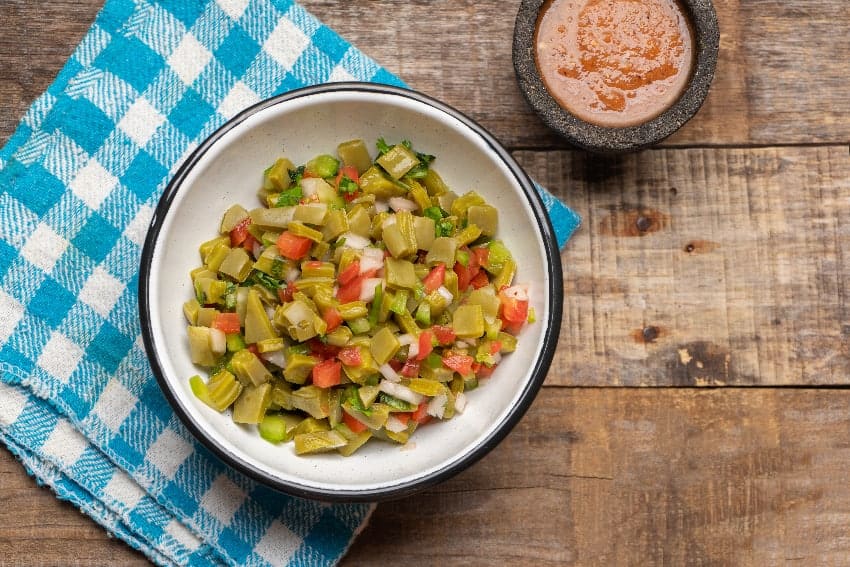Mexico’s mighty nopal is a prickly culinary delight

For centuries, the nopal cactus – of the opuntia genus, also known as prickly pear – has symbolized resilience and adaptability, much like the Mexican people. In exploring the wisdom behind Mexican cuisine’s tapestry of seemingly modest ingredients, the mighty nopal is not to be missed!
Indigenous civilizations revered the cactus, recognizing its nutritional value and healing properties. It was also considered a sacred plant, appearing famously in the legend of the founding of Tenochtitlan by the Mexica (or Aztecs). The story says that an eagle devouring a snake while perched on a nopal was the sign that the Mexica were seeking to know where to build their city, and the image became the national coat of arms.
What is nopal’s nutritional profile? The nopal’s composition is primarily water, giving it a refreshingly light and crisp texture. With a low caloric value of a mere 27 calories per 100 grams, it also boasts minimal digestible carbohydrates, making it a low-glycemic index food.
Nopal pads are also rich in soluble fibers, like pectins, gums, and mucilage. As a result, consuming nopal has been associated with a sensation of satiety, which aids in weight management and curbs excessive food intake. But wait, there’s more! The nopal’s fiber content can also contribute to regulating blood glucose levels.
The use of nopal in Mexican cuisine stretches back to pre-Columbian times, when it served as a dietary staple for the ancient Mesoamericans. Its versatility and abundance made it a vital ingredient, contributing to the sustenance and survival of these communities.
Fast forward to the present day, and the nopal’s culinary prowess has only grown stronger. In kitchens across Mexico, from bustling taquerías to high-end restaurants, the nopal is celebrated as a versatile and unique ingredient. Its tender pads, stripped of their spines, are sliced, diced, grilled, and sautéed to create a myriad of culinary delights.

The quintessential dish of nopalitos is a chilled salad made of cooked chopped nopal, tomatoes, onions and cilantro that is especially welcome during hot summer months.
My grandma’s cook would always add her treasured copper penny to the boiling pot of nopal, saying that was her secret to preserving their vibrant natural hue. Who knows? There are as many secret tricks as there are kitchens in Mexico.
Salvador Novo, in his fascinating book “Cocina Mexicana o Historia Gastronómica de la Ciudad de Mexico” published in 1967, writes about the nopal, which I translate below:
“Let’s think about the nopal. Let’s approach the contemplation of this strange desert plant that seems to greet passersby, or show them the path. It was born who knows how: sticking out its flat hands, an oval flat face from which one more sprouts, and another from this one, and another. All defended by sharp thorns geometrically installed on thick pads, and yet they are smooth under the numerous violent needles.
Nobody waters it, nobody cultivates it. It sips vital juices from the driest earth, from its rock throne. And one fine day, small red fingers sprout from those broad, flat hands: prickly pears, red as men’s hearts; sheltered, wrapped in the peel, where they briefly repeat, like a soft rhyme, the hostile geometry of their cradle’s thorns, their sustenance.”
So, my friends, let us (carefully) embrace the prickly nopal, and allow it to lead us to a delicious world of good health.
If you’re ready to start preparing nopal in your kitchen, the recipe below is a good place to start.

Nopalitos salad
- 8 medium-sized tender nopal pads
- 1/2 white onion
- 4 small tomatoes
- 1 bunch of fresh cilantro
- 1 tablespoon of apple cider vinegar or fresh lime juice
- 1 teaspoon of salt and 1 teaspoon of pepper for seasoning
Cut cactus pads into 3/4-inch pieces. Rinse them 2-3 times under running water.
Place the nopal pieces in a medium saucepan with enough water to cover them and a tablespoon of salt. Bring to a boil. Reduce heat to a simmer and cook uncovered for 20 to 25 minutes or until tender but still crisp.
Drain and let cool.
Place the cooked nopalitos in a large bowl, add diced tomatoes, chopped onion, cilantro, a pinch of dried oregano, salt, and pepper. Mix to combine all the ingredients. Add a tablespoon of lemon juice or apple cider vinegar and mix evenly.
Refrigerate for at least 2 hours to allow the flavors to blend. Serve chilled.
Sandra is a Mexican writer and translator based in San Miguel de Allende who specializes in mental health and humanitarian aid. She believes in the power of language to foster compassion and understanding across cultures. She can be reached at: [email protected]
Source: Mexico News Daily

